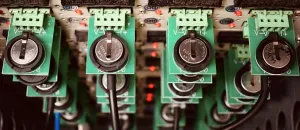INFORMATION:
The manuscript was published online in ACS Sensors, but has also been recognized as an ACS Editor's Choice Article. Additional authors include Dr. Xiaoxin Zheng, a former postdoctoral fellow in Dr. Jaffer's lab at the MGH, and Dr. Chase Kessinger, an Instructor from the MMRI. The paper, titled, "In Vivo Platelet Detection Using a Glycoprotein IIb/IIIa-Targeted Near-Infrared Fluorescence Imaging Probe," was officially published on May 31, 2021, and can be viewed at pubs.acs.org/doi/10.1021/acssensors.1c00124.
MMRI is dedicated to scientific research that improves the health and quality of life for all. We strive to conduct high quality research aimed at developing a deep understanding of diseases and generating innovative cures and treatments. For more information about MMRI, please visit mmri.edu.
Masonic Medical Research Institute researchers develop new imaging agent to detect activated platelets
Tools for clinicians in point-of-care use
2021-06-17
(Press-News.org) UTICA, NY -- More than 2 million coronary artery stents are implanted each year to help protect or restore normal blood flow to the heart, to treat patients suffering from angina or a heart attack due to coronary artery disease (CAD). While stents are highly effective and safe devices, scarring or clotting of unhealed stents can occur in a small percentage of subjects, leading to complications such as stent restenosis or thrombosis, which can be life-threatening. At present, approaches to understand stent healing based on their biological clotting status is unavailable in patients.
To devise a potential solution to this problem, Dr. Jason McCarthy, an Associate Professor at the Masonic Medical Research Institute (MMRI), and his team have developed a fluorescent probe that binds to activated platelets, one of the main cell types involved in the clotting and scarring process of improperly healed stents. "By using a new platelet-targeted molecular imaging agent coupled with fluorescence imaging, in particular intravascular catheter-based imaging, we are enabling a new approach to localize and visualize platelets during or after coronary stent implantation. This tool has the potential to enable clinicians to proactively treat patients before the development of occlusive stent clotting or scarring, as opposed to reactively, when the patient is symptomatic," said Dr. Jason McCarthy, co-senior author on the manuscript.
In a collaboration with Dr. Farouc A. Jaffer, an Interventional Cardiologist at Massachusetts General Hospital (MGH) and an Associate Professor of Medicine at Harvard Medical School, the team modified a drug called tirofiban, an FDA-approved compound known to bind to activated platelets, to enable a fluorescence-based strategy for the detection of platelet-rich clots in experimental subjects.
Stent implantation is a routine invasive procedure in which a stent is delivered over a coronary wire to the target lesion location. Given that clinicians already have intracoronary wire access during this procedure, performing imaging of platelet deposition using fluorescence-based catheters can be readily accomplished (fluorescence catheters have already been tested in patients). "Once the interventional cardiologist is ready to image platelet deposition on stents, a small amount of our new platelet-targeted imaging agent will be intravenously administered. After a few minutes, a fluorescence imaging catheter will be delivered down the coronary over the same wire, followed by an imaging pullback to visualize whether there are any platelets adhered to the stent, which may indicate that it is prone to further development of clots. This will give the clinician the option at the point-of-care to change pharmacological or interventional management of the patient to optimize their outcomes," said Dr. McCarthy.
The manuscript details the process by which the team created and tested the novel imaging agent. "This new agent provides tools that open up numerous possibilities for translational cardiovascular imaging, especially at the point-of-care," said Dr. Khanh Ha, co-author on the paper, and postdoctoral fellow at the MMRI, "With the imaging catheters already approved for clinical use, the goal was to create an imaging agent that would hopefully also prove clinically translatable."
ELSE PRESS RELEASES FROM THIS DATE:
Passive rewilding can rapidly expand UK woodland at no cost
2021-06-17
A long-term passive rewilding study has shown that natural woodland regeneration could make a significant contribution to meeting the UK's ambitious tree planting targets - potentially at no cost and within relatively short timescales.
The research, led by the UK Centre for Ecology & Hydrology (UKCEH), found natural growth due to seed dispersal by birds, mammals and wind can produce biodiverse and resilient woodland.
Woodland development can be rapid, while avoiding the cost, management and plastic tubing involved in planting schemes.
The study - published in the journal PLOS ONE - found that after just 15 years, previously bare agricultural ...
Probing the dynamics of photoemission
2021-06-17
Physicists at Ludwig-Maximilian University in Munich (LMU) and the Max Planck Institute for Quantum Optics (MPQ) have used ultrashort laser pulses to probe the dynamics of photoelectron emission in tungsten crystals.
Almost a century ago, Albert Einstein received the Nobel Prize for Physics for his explanation of the photoelectric effect. Published in 1905, Einstein's theory incorporated the idea that light is made up of particles called photons. When light impinges on matter, the electrons in the sample respond to the input of energy, and the interaction gives rise to what is known as the photoelectric effect. Light quanta (photons) are absorbed by the ...
Adding checkpoint inhibition to anti-HER2 breast cancer therapy brings no benefit
2021-06-17
Lugano, Switzerland, 17 June 2021 - Adding an immune checkpoint inhibitor to anti-HER2 treatment in breast cancer does not improve pathological complete response (pCR), according to the primary analysis of the IMpassion050 trial presented today during the ESMO Virtual Plenary. (1) The phase III trial is the first to report data comparing a neoadjuvant anti-HER2 based regimen with or without the anti-PD-L1 antibody atezolizumab in patients with high-risk, HER2-positive early breast cancer.
The standard treatment for high-risk, HER2-positive early breast cancer is dual anti-HER2 blockade plus chemotherapy. While antibody therapy may enhance innate and adaptive immunity and activate cellular cytotoxicity, there is evidence ...
Researchers identify gene responsible for increased risk of infantile fragility
2021-06-17
(Boston)--An intrauterine fracture is a rare finding during routine prenatal imaging. This condition can be due to maternal trauma, genetic disorders of the skeleton, as well as other predisposing maternal metabolic and vascular disorders. Genetic disorders that have previously been reported to cause intrauterine fracture include brittle bone disease (osteogenesis imperfecta or OI), osteopetrosis, hypophosphatasia and Ehlers-Danlos syndrome (EDS).
Now for the first time, researchers from Boston University School of Medicine (BUSM) report a new genetic cause, unrelated to OI, for the 23 fractures that occurred in-utero to a mother with EDS hypermobility type.
EDS is a disease that weakens the bones and connective tissues ...
Asymptomatic pertussis more common in infants than previously thought
2021-06-17
New study challenges long-standing assumptions about disease severity in infants, and suggests that standard qPCR interpretations underestimate the true burden of other highly contagious diseases, such as COVID-19 and influenza.
Pertussis, also known as "whooping cough," remains a significant cause of death in infants and young children around the world and, despite global vaccination programs, many countries are experiencing a resurgence of this highly contagious disease.
A new study by Boston University School of Public Health and the University of Georgia's Odum School of Ecology presents evidence that could help explain this ...
Red meat consumption may promote DNA damage-assoc. mutation in colorectal cancer patients
2021-06-17
Bottom Line: Genetic mutations indicative of DNA damage were associated with high red meat consumption and increased cancer-related mortality in patients with colorectal cancer.
Journal in Which the Study was Published: Cancer Discovery, a journal of the American Association for Cancer Research
Author: Marios Giannakis, MD, PhD, an assistant professor of medicine at Harvard Medical School and a physician at Dana-Farber Cancer Institute
Background: "We have known for some time that consumption of processed meat and red meat is a risk factor for colorectal cancer," said Giannakis. The International Agency for Research on Cancer declared that processed meat was carcinogenic and that red meat was probably carcinogenic to humans in 2015.
Experiments ...
Engineered NK cells can eliminate glioblastoma stem cells
2021-06-17
HOUSTON ? Preclinical research from The University of Texas MD Anderson Cancer Center finds that although glioblastoma stem cells (GSCs) can be targeted by natural killer (NK) cells, they are able to evade immune attack by releasing the TFG-β signaling protein, which blocks NK cell activity. Deleting the TFG-β receptor in NK cells, however, rendered them resistant to this immune suppression and enabled their anti-tumor activity.
The findings, published today in the Journal of Clinical Investigation, suggest that engineering NK cells to resist immune suppression may be a feasible path ...
Hybrid membrane doubles the lifetime of rechargeable batteries
2021-06-17
The energy density of traditional lithium-ion batteries is approaching a saturation point that cannot meet the demands of the future - for example in electric vehicles. Lithium metal batteries can provide double the energy per unit weight when compared to lithium-ion batteries. The biggest challenge, hindering its application, is the formation of lithium dendrites, small, needle-like structures, similar to stalagmites in a dripstone cave, over the lithium metal anode. These dendrites often continue to grow until they pierce the separator membrane, causing the battery to short-circuit and ultimately destroying ...
Excess nitrogen puts butterflies at risk
2021-06-17
Nitrogen from agriculture, vehicle emissions and industry is endangering butterflies in Switzerland. The element is deposited in the soil via the air and has an impact on vegetation - to the detriment of the butterflies, as researchers at the University of Basel have discovered.
More than half of butterfly species in Switzerland are considered to be at risk or potentially at risk. Usually, the search for causes focuses on intensive agriculture, pesticide use and climate change. A research team led by Professor Valentin Amrhein from the University of Basel, however, has been investigating another factor - the depositing ...
Response to DNA damage: The dual role of extramitochondrial cytochrome C
2021-06-17
Living beings are continuously exposed to harmful agents, both exogenous (ultraviolet radiation, polluting gases, etc.) and endogenous (secondary products of cellular metabolism) that can affect DNA integrity. That's why cells are endowed with a series of molecular mechanisms whose purpose is to identify and signpost possible damage to the genetic material for speedy repair. These mechanisms are precisely regulated because they are key to cell survival. In extreme situations of massive and irreparable damage, cells enter a phase of controlled dismantling called "programmed cell death". Among the events that take place during this process is the massive delivery to the cytoplasm of a mitochondrial protein called cytochrome C. Under homeostatic conditions, this protein plays a role in energy ...
LAST 30 PRESS RELEASES:
On-demand upgraded recycling of polyethylene and construction of sustainable multifunctional materials based on the "LEGO" strategy
New "Stomata in-sight" system allows scientists to watch plants breathe in real-time
Anorexia nervosa may result in long-term skeletal muscle impairment
Narrative-based performance reviews deemed fairest by employees
New insights reveal how advanced oxidation can tackle emerging water pollutants
New review shows how biomass can deliver low-carbon gaseous fuels at scale
Climate change is quietly rewriting the world’s nitrogen cycle, with high stakes for food and the environment
Study finds SGLT-2 inhibitors linked to lower risk of diabetic foot nerve damage
Microbes may hold the key to brain evolution
Study examines how the last two respiratory pandemics rapidly spread through cities
Gender stereotypes reflect the division of labor between women and men across nations
Orthopedics can play critical role in identifying intimate partner violence
Worms as particle sweepers
Second spider-parasitic mite described in Brazil
January 2026 issues of APA journals feature new research on autism, pediatric anxiety, psychedelic therapy, suicide prevention and more
Private equity acquired more than 500 autism centers over the past decade, new study shows
New cervical cancer screening guidelines from the US Department of Health and Human Services
Estimated burden of COVID-19 illnesses, medical visits, hospitalizations, and deaths in the US from October 2022 to September 2024
Smartphone use during school hours by US youth
Food insecurity and adverse social conditions tied to increased risk of long COVID in children
Earliest, hottest galaxy cluster gas on record could change our cosmological models
Greenland’s Prudhoe Dome ice cap was completely gone only 7,000 years ago, first GreenDrill study finds
Scientific validity of blue zones longevity research confirmed
Injectable breast ‘implant’ offers alternative to traditional surgeries
Neuroscientists devise formulas to measure multilingualism
New prostate cancer trial seeks to reduce toxicity without sacrificing efficacy
Geometry shapes life
A CRISPR screen reveals many previously unrecognized genes required for brain development and a new neurodevelopmental disorder
Hot flush treatment has anti-breast cancer activity, study finds
Securing AI systems against growing cybersecurity threats
[Press-News.org] Masonic Medical Research Institute researchers develop new imaging agent to detect activated plateletsTools for clinicians in point-of-care use



